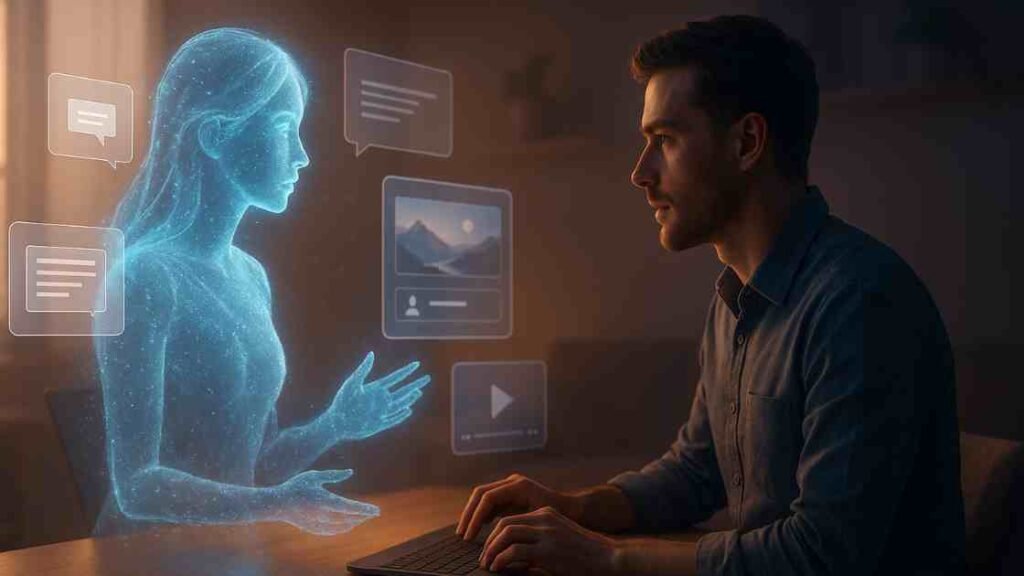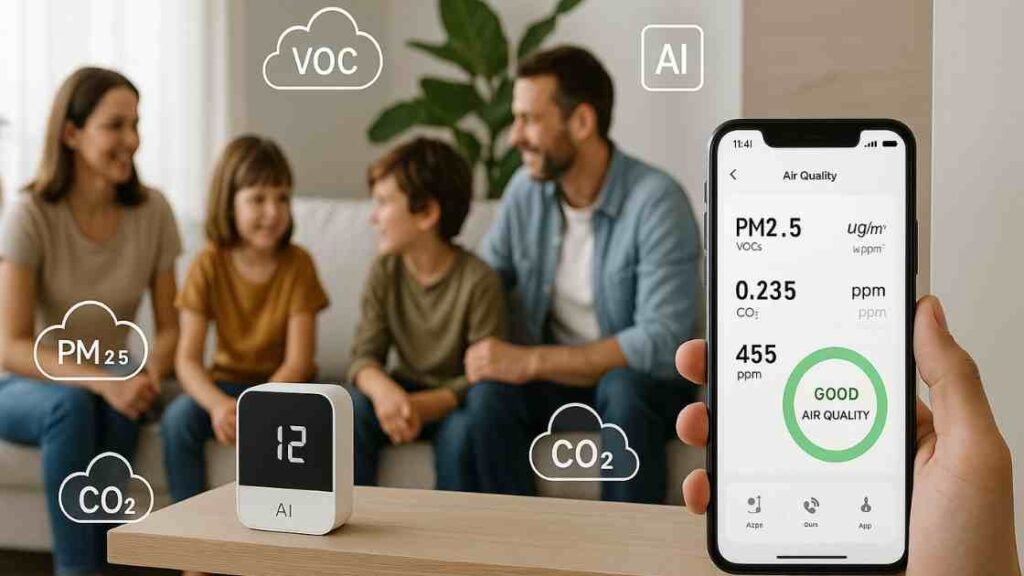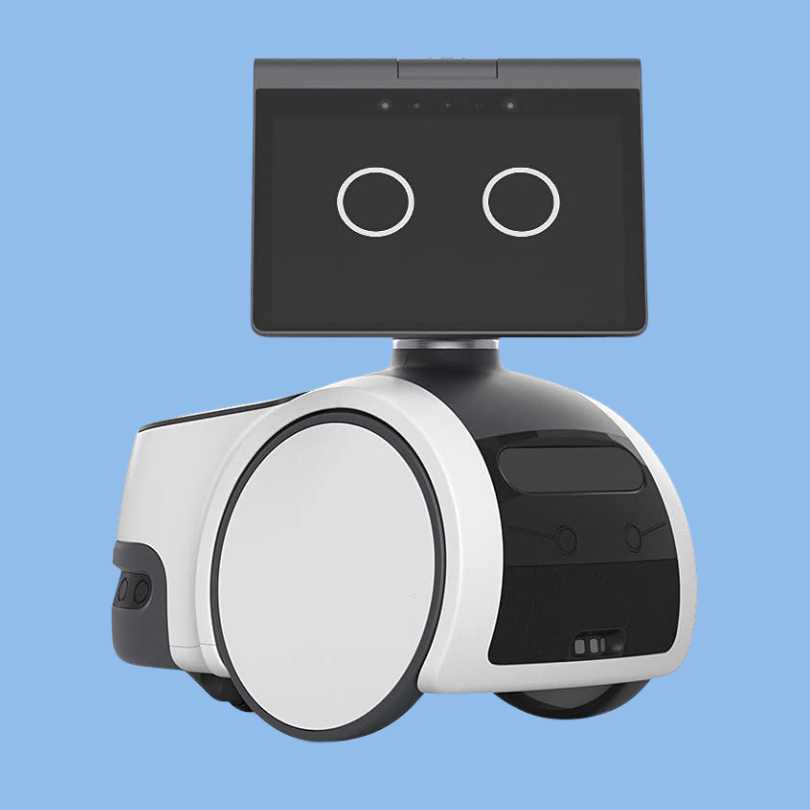ChatGPT in 2025: 10 Real-World Ways People Are Using It Daily

From Curiosity to Everyday Companion
ChatGPT use cases 2025 reflect how deeply this AI has integrated into modern life — far beyond its origins as a simple chatbot. What started as a conversational experiment has now evolved into a universal AI assistant that millions rely on daily to work smarter, study better, and create faster.
With GPT-5’s multimodal capabilities (see OpenAI’s announcement), ChatGPT can now understand text, voice, images, and even videos, making it a far more intuitive tool than its earlier versions. From drafting professional reports and generating code to building lesson plans or crafting viral social media campaigns, ChatGPT has become an invisible co-pilot in nearly every profession.
From wearables to smart assistants, innovations featured in our guide on 10 Best AI Gadgets You Need in 2025 show how AI tools like ChatGPT are redefining the modern lifestyle.
In this article, we’ll explore 10 real-world ChatGPT use cases in 2025 — practical, proven ways people are using it every day to enhance productivity, creativity, and learning.
1. Content Creation and Blogging
One of the most impactful ChatGPT use cases in 2025 is in content creation and blogging. Modern creators — from tech bloggers and digital marketers to YouTubers and newsletter writers — rely on ChatGPT to brainstorm fresh topics, craft SEO-friendly outlines, and polish final drafts faster than ever.
Integrations with Rank Math, SurferSEO, and Notion AI
Today, ChatGPT integrates seamlessly with powerful tools like Rank Math, SurferSEO, and Notion AI, creating a connected ecosystem for writers. A blogger can, for example, ask ChatGPT to generate a keyword cluster based on Google Search Console insights, refine on-page elements like meta titles or schema through Rank Math, and check semantic relevance through SurferSEO — all within one workflow.
This evolution has made the AI-assisted content workflow far more intelligent and context-driven. ChatGPT now understands search intent, topic hierarchy, and entity relationships, allowing writers to move beyond keyword stuffing into a deeper semantic SEO strategy. It automatically identifies content gaps, recommends supporting subtopics, and even suggests internal links to boost topical authority — something traditional SEO tools once did in isolation.
The AIO Workflow: Combining AI Drafting with Human Editing
The rise of AI-generated writing has also encouraged a shift toward the AIO approach — AI + human optimization. In 2025, the most successful bloggers are those who treat ChatGPT as a creative partner rather than a replacement. They use it to accelerate research and ideation, while human editors ensure authenticity, accuracy, and emotional tone. This balanced approach aligns with Google’s E-E-A-T principles (Experience, Expertise, Authoritativeness, and Trustworthiness) (see Google’s content guidelines) — key factors in ranking high under the Helpful Content Update.
Ethically, content creators are also becoming more transparent about their AI content ethics — disclosing AI assistance, maintaining factual accuracy, and crediting original sources. Rather than flooding the internet with generic articles, responsible writers now use ChatGPT to enhance their own perspective, storytelling, and voice.
Example: How a Tech Blog Uses ChatGPT for SEO and CTR Optimization
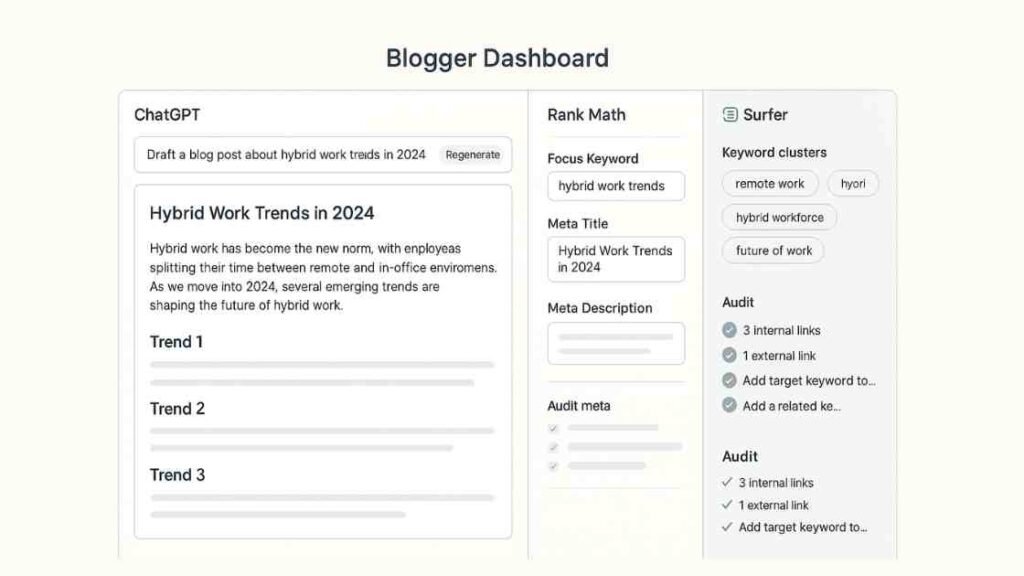
A blogger managing a tech website like GadgetsBuzz.co.uk can prompt ChatGPT to identify trending article ideas such as “Best AI Gadgets 2025” or “How Foldable Phones Redefined Portability.” It can then generate structured outlines, optimized meta descriptions, and internal link suggestions, while the writer adds human insights, screenshots, and comparisons to make the piece credible and engaging.
In short, ChatGPT and semantic SEO together have redefined content creation — transforming it from a time-intensive task into a data-driven, creative process where humans focus on storytelling and strategy, and AI handles research and optimization in the background.
2. Academic Research and Study Help
One of the fastest-growing ChatGPT use cases in 2025 lies in academic research and learning support. What began as a simple homework helper has evolved into a full-scale AI study companion capable of assisting students, educators, and researchers at every academic level — from high-school learners to PhD candidates.
Integrations with ScholarAI, ResearchRabbit, and Semantic Scholar
In 2025, ChatGPT integrates with educational platforms like ScholarAI, ResearchRabbit, Elicit, and Semantic Scholar, allowing users to search, summarize, and analyze peer-reviewed studies in seconds. A psychology student can upload journal PDFs and ask, “Summarize these findings in APA format,” while a computer-science researcher can prompt, “Explain how reinforcement learning differs from supervised learning in practical terms.” ChatGPT processes these complex requests with improved factual accuracy and contextual awareness, helping users grasp advanced topics faster.
Ethical AI Use: Citations, Fact-Checking, and Academic Integrity
Many universities now encourage the ethical and transparent use of AI tools. ChatGPT provides built-in citation suggestions, explains academic frameworks, and supports referencing styles such as APA, MLA, and Chicago, minimizing the risk of unintentional plagiarism. Institutions use AI-literacy workshops to teach students how to fact-check and cross-reference results, reinforcing the principle that AI should assist, not replace, critical thinking or originality.
Beyond research writing, ChatGPT is now a personal study planner and note organizer. Integrated with apps like Notion AI and Evernote, it structures lecture notes, converts voice recordings into key summaries, and creates quick-review flashcards for exams. Students can even generate custom quizzes or concept maps, turning passive reading into active learning.
For academic professionals, ChatGPT saves time by drafting abstracts, proposal outlines, and literature-review summaries. It can translate academic texts across languages, improve grammar while preserving technical precision, and adjust tone for journal submissions — a major aid for non-native English speakers.
However, as universities adopt AI detection and integrity tools, a new culture of responsible AI use has emerged. Educators emphasize human verification, citation transparency, and peer review, ensuring that AI-generated insights are always supplemented with genuine academic rigor. This balance between human expertise and AI efficiency defines the AIO learning model — AI plus Original insight — the new gold standard of academic excellence in 2025.
Real-World Example: Thesis Support with ChatGPT Summarization
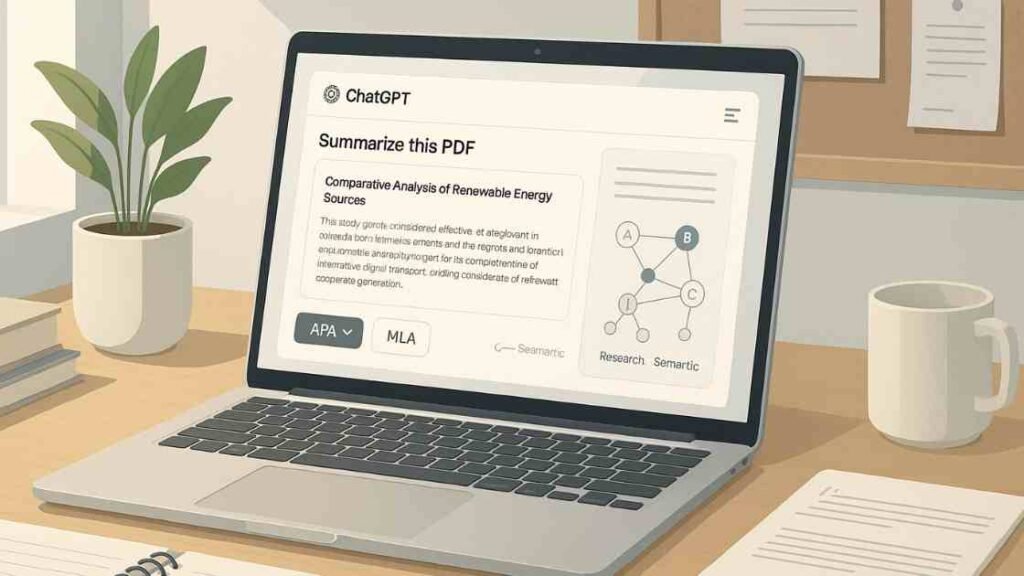
Real-world example: A postgraduate student writing a thesis on “Cognitive Load Theory in Digital Learning Environments” can use ChatGPT to summarize foundational papers, compare methodologies, and even structure chapters with logical flow. Yet, the student remains the author — using AI for clarity and organization while ensuring that every interpretation is critically evaluated.
In essence, ChatGPT has transformed academic study from information overload to informed understanding. By combining intelligent summarization with human reflection, it bridges the gap between raw data and true knowledge — empowering the next generation of thinkers, researchers, and innovators.
3. Business Communication and Copywriting
In 2025, one of the most transformative ChatGPT use cases is in business communication and copywriting. Across industries, professionals depend on ChatGPT to draft compelling emails, marketing
In 2025, one of the most transformative ChatGPT use cases is in business communication and copywriting. Across industries, teams now depend on ChatGPT to craft professional emails, marketing materials, and internal documents that maintain clarity, consistency, and brand personality. What once took hours of drafting and editing can now be completed in minutes with AI precision — freeing human teams to focus on strategy and creativity.
AI Writing Integration with Slack, Notion, and Microsoft Copilot
Modern communication platforms such as Slack AI, Notion AI, and Microsoft Copilot for Office 365 integrate directly with ChatGPT, turning every workspace into an intelligent writing environment. A marketing team can ask the assistant to “rewrite this product update in an enthusiastic tone for LinkedIn,” or a sales manager can command, “summarize today’s client meeting into bullet points and send follow-up reminders.” Within seconds, ChatGPT produces polished drafts that align with each company’s preferred tone and structure.
Personalized Outreach Using CRM Tools like HubSpot and Zoho
Businesses are also using ChatGPT with CRM tools like HubSpot and Zoho CRM to personalize outreach. Instead of generic mass emails, ChatGPT analyzes customer data and generates tailored follow-ups or newsletters that reflect individual preferences and purchase history. This form of AI-powered personalization has significantly improved click-through and engagement rates while maintaining a human touch.
The AIO Workflow: Blending Human Tone with AI Precision
When it comes to marketing copywriting, ChatGPT now rivals dedicated tools such as Jasper or Copy.ai. It can generate social-media captions, ad headlines, product descriptions, or full landing-page drafts while staying aligned with brand voice. The 2025 version of ChatGPT allows marketers to upload brand-tone guides or content frameworks, so every piece of writing mirrors the organization’s unique style — whether playful, professional, or minimalist.
Yet, even with this automation, brands are adopting a mindful AIO workflow (AI + Human Optimization). Human editors review AI-generated drafts to refine storytelling, inject emotional nuance, and ensure cultural sensitivity. This partnership between machine efficiency and human creativity upholds AI content ethics, ensuring the communication remains authentic, accurate, and trustworthy — values that align with Google’s E-E-A-T principles.
ChatGPT has also become indispensable for B2B and internal communication. Executives use it to draft policy updates, prepare investor letters, or summarize reports in plain language for non-technical staff. HR departments use it to write inclusive job descriptions, craft employee newsletters, and even script onboarding videos. Because ChatGPT can understand sentiment and tone, it helps organizations communicate more empathetically and transparently — a vital skill in modern hybrid workplaces.
Example: Drafting Client Follow-Ups and Internal Memos with ChatGPT
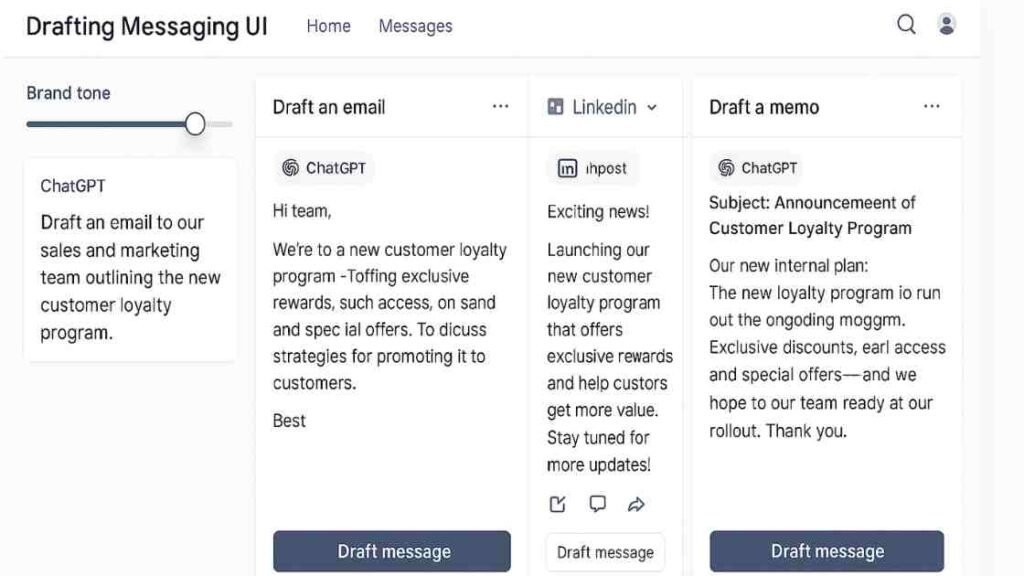
Example: A marketing manager might prompt ChatGPT to “write a friendly follow-up email for a client who hasn’t responded in a week, keeping a polite yet confident tone.” The assistant instantly produces a message that feels natural and brand-aligned, ready to send after a quick human review.
Ultimately, ChatGPT in 2025 has redefined how businesses write, collaborate, and connect. It blends efficiency with creativity, ensuring every piece of communication — from corporate memos to viral ad copy — conveys professionalism, clarity, and authenticity. Companies that master this AI-human partnership not only communicate faster but also build stronger, more consistent brand voices in a crowded digital world.
4. Coding and Software Development
Among the most practical ChatGPT use cases in 2025, software development continues to stand out as one of the most transformative. Developers now rely on ChatGPT as a real-time coding assistant, debugger, and learning partner — a digital co-pilot that bridges the gap between problem-solving and production-level code.
Unlike earlier versions that only offered general suggestions, ChatGPT in 2025 can understand full project context. Developers can paste hundreds of lines of code, specify programming languages or frameworks, and receive targeted feedback that accounts for architecture, logic, and dependencies. Its multimodal comprehension even allows it to interpret screenshots or flowcharts, explaining logic errors or offering architecture optimization tips.
Integration with GitHub Copilot X, VS Code, and Replit Ghostwriter
ChatGPT integrates natively with major development environments such as GitHub Copilot X, Replit Ghostwriter, VS Code Chat, and JetBrains AI Assistant. This integration enables live pair-programming sessions where developers can type commands like “refactor this function for better memory efficiency,” or “generate a REST API endpoint for this schema.” The AI executes or suggests relevant snippets instantly, helping both beginners and advanced engineers accelerate their workflow.
Debugging has also evolved dramatically. ChatGPT doesn’t just point out syntax errors — it explains why the bug exists, provides multiple fix options, and outlines potential edge cases. Developers can now hold natural-language conversations about their code, asking questions such as “Why does my React component re-render unnecessarily?” or “How can I optimize this SQL query for faster performance?” The AI responds with structured reasoning, code samples, and practical implementation steps.
For documentation, ChatGPT automatically generates clear, human-readable explanations, helping teams maintain consistency across projects. With one prompt, developers can produce API documentation, changelogs, and inline comments that meet open-source standards. This has reduced time spent on administrative work and improved team collaboration in multi-developer projects.
AI Code Reviews, Documentation, and Quality Assurance
AI-driven software creation has also opened doors for non-developers and startups. Entrepreneurs can now describe an idea in plain English — for instance, “Create a web app that allows users to upload photos and apply filters like Instagram” — and ChatGPT will produce the front-end, back-end, and database logic along with deployment steps. Combined with tools like Replit Deploy, Firebase AI, and Vercel Edge Functions, even small teams can build scalable apps within days instead of months.
The introduction of AI code review systems has further refined quality control. ChatGPT, when connected to repositories via APIs, can analyze commit histories, detect inconsistent naming conventions, and flag potential security vulnerabilities. It acts as both a senior developer and mentor, guiding teams toward cleaner, more maintainable codebases.
Educationally, ChatGPT has revolutionized programming learning. New developers use it to understand fundamental concepts like recursion, object-oriented design, or data structures. Instead of searching forums, learners can now engage in interactive debugging conversations, with ChatGPT breaking down complex logic into digestible explanations.
Example: Building Responsive Components with Tailwind CSS
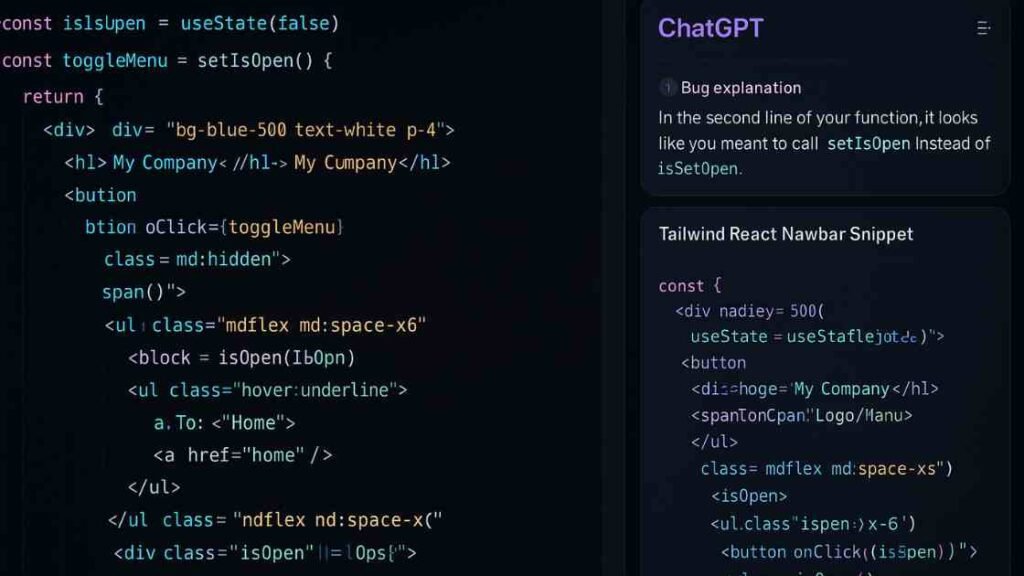
Example: A front-end developer working on a React project can prompt: “Generate a responsive navigation bar with Tailwind CSS that includes a dropdown for mobile view.” Within seconds, ChatGPT delivers production-ready code with step-by-step instructions for integration, saving hours of manual setup.
In 2025, AI-assisted programming is no longer an experiment — it’s a necessity. By combining ChatGPT’s generative power with human oversight, developers can produce faster, cleaner, and more secure software. This symbiotic relationship between human creativity and machine precision marks a new era in software engineering — where coding becomes less about syntax and more about problem-solving, design, and innovation.
5. Productivity and Workflow Automation
In 2025, productivity and workflow automation have become some of the most practical and time-saving ChatGPT use cases across industries. Whether in offices, startups, or home-based freelancing environments, professionals are using ChatGPT as a personal productivity hub — automating everyday tasks, summarizing data, and organizing work seamlessly through natural conversation.
Integration with Zapier, Notion, Google Workspace, and Asana
Modern integrations have elevated ChatGPT from a text generator to a true AI productivity assistant. Connected with Zapier, Google Workspace, Notion AI, Asana, and Trello, ChatGPT can now interpret human language commands like, “Create a new task for tomorrow’s client presentation and share the meeting link with my team,” and execute the workflow automatically. Through Zapier automations, it can trigger follow-up emails, update CRM records, or even post task reminders to Slack — reducing manual digital clutter that drains time and focus.
In offices, ChatGPT is the new virtual chief of organization. Teams use it to summarize lengthy reports, extract actionable insights, and draft weekly updates for management. Its ability to process multi-document context allows it to compile large project data, generate progress summaries, and visualize information in the form of bullet points, tables, or slides. Connected to Google Sheets or Docs, it can automatically populate reports, prepare summaries, or calculate performance metrics, eliminating repetitive tasks that once required hours of manual effort.
AI for Email, Calendar, and Time Management
Professionals also use ChatGPT for email and calendar automation. Integrated with Google Calendar and Gmail, it schedules meetings, sends polite follow-ups, and even drafts personalized replies based on context. For example, a project manager can say, “Summarize all my unread emails from this morning and schedule the most urgent meetings for tomorrow,” and ChatGPT handles the entire process with precision.
When connected with Notion AI or ClickUp, ChatGPT enhances task prioritization and knowledge management. It can organize project notes, categorize client feedback, and suggest smart deadlines based on workload balance. Many freelancers and remote teams use these integrations to maintain productivity while ensuring no detail slips through the cracks.
Time management, one of the hardest professional challenges, has also been redefined by AI. ChatGPT can now function as a personal performance coach, analyzing work patterns and suggesting productivity techniques like time-blocking, the Pomodoro method, or energy-based scheduling. By combining task data from multiple apps, it can even recommend when to focus, collaborate, or take breaks — turning productivity into a science, not guesswork.
Beyond individual use, businesses leverage ChatGPT for cross-department automation. Marketing teams use it to draft campaign reports; HR departments use it to summarize employee surveys; and finance teams use it to generate monthly budget summaries from raw spreadsheets. Each department benefits from AI-driven summarization and task delegation, freeing staff for more creative or strategic work.
Example: Automating Weekly Reports and Summaries with ChatGPT
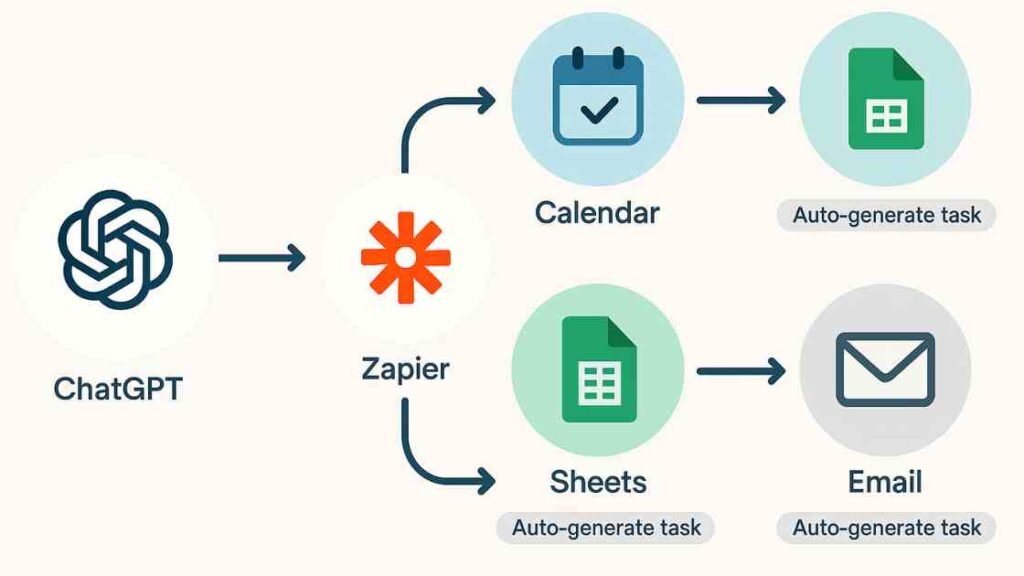
Example: A small business owner can simply say, “Create an automated weekly report that gathers website traffic from Google Analytics, generates a summary, and emails it to my marketing team.” ChatGPT, connected through Zapier and Google Workspace, executes this end-to-end process without manual input.
In essence, ChatGPT in 2025 has turned productivity into a conversation. No more endless toggling between apps or copy-pasting data — you simply tell ChatGPT what you need, and it does the rest. This seamless interaction between natural language and automation tools marks a major leap in workplace efficiency, proving that when AI handles the busywork, humans can finally focus on what truly matters: creativity, innovation, and meaningful results.
Similarly, innovations in smart environments — like those featured in AI Gadgets for Monitoring Indoor Air Quality — show how AI-driven automation now extends beyond workspaces to make homes healthier and more adaptive.
6. Personal Learning and Skill Building
In 2025, one of the most empowering ChatGPT use cases lies in personal learning and continuous skill development. What once required expensive online courses or rigid curriculums is now available on demand — personalized, adaptive, and interactive. ChatGPT has become a 24/7 digital tutor, guiding millions through coding, design, writing, public speaking, and even emotional intelligence training, all through natural conversation.
The modern learner uses ChatGPT to build custom study paths. For example, an aspiring UX designer can ask, “Create a 4-week learning roadmap to master user research and prototyping,” and ChatGPT curates a structured plan with daily lessons, recommended readings, and project-based challenges. It even suggests free and paid resources from trusted platforms like Coursera, Khan Academy, and Udemy, allowing learners to balance affordability and depth.
Adaptive Learning through Continuous Feedback
What makes ChatGPT different from traditional learning tools is its adaptive intelligence. It analyzes a user’s progress, identifies weaknesses, and adjusts the difficulty of lessons dynamically. For instance, if a user struggles with advanced Python loops or SQL joins, ChatGPT provides simplified analogies, visual breakdowns, and quizzes to reinforce understanding before moving ahead. This mirrors the personalized attention of a human tutor, but scaled through AI precision.
Professionals now use ChatGPT for career upskilling — especially in industries reshaped by automation and AI. Marketing specialists learn prompt engineering and data storytelling, while teachers explore ways to integrate generative AI into the classroom. Engineers, meanwhile, use ChatGPT to master frameworks like React or TensorFlow by asking real-time technical questions during projects. By blending micro-learning with live interaction, ChatGPT has made skill acquisition faster, contextual, and deeply engaging.
Integrations with Coursera, Notion AI, and Obsidian
Integration with tools like Notion AI, Readwise, and Obsidian has turned ChatGPT into an intelligent learning companion. It organizes study notes, highlights key takeaways, and connects concepts across disciplines — helping learners build a long-term “second brain.” You can ask, “Summarize my notes on leadership and link them with emotional intelligence studies,” and ChatGPT will synthesize both subjects, showing how soft skills enhance workplace success.
This AI-powered learning also nurtures soft and creative skills that traditional education often overlooks. Learners practice negotiation, empathy, or public speaking by simulating real-world dialogues with ChatGPT. Writers use it for creative writing drills, and students use it to rehearse presentations, refine arguments, and gain confidence before real exams or interviews.
Still, the most valuable evolution in 2025 is the rise of ethical learning through AI. ChatGPT encourages reflection, curiosity, and critical thinking rather than rote memorization. It prompts users to explore multiple perspectives on a topic, question assumptions, and build informed opinions — aligning education with real-world adaptability and moral reasoning.
Example: Simulating Job Interviews and Professional Scenarios
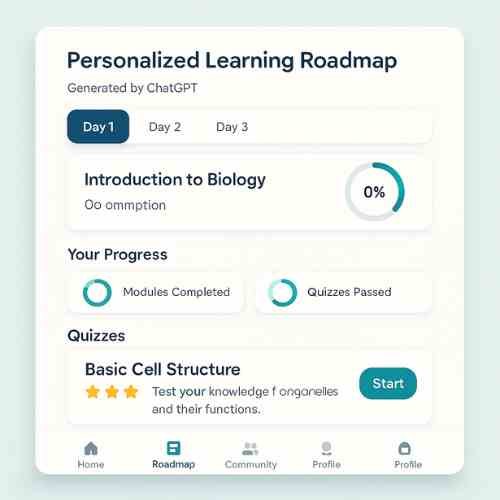
Example: A UX designer preparing for a job interview can prompt ChatGPT to “simulate a behavioral interview for a design role at Google.” The assistant asks realistic questions, provides constructive feedback, and even scores answers based on empathy, clarity, and analytical depth.
Ultimately, ChatGPT has turned learning into a lifelong conversation. It empowers individuals to continuously evolve — not just by absorbing information, but by applying knowledge meaningfully. In a rapidly changing world where skills expire quickly, ChatGPT acts as both mentor and motivator, ensuring that education never stops, no matter where you are in your journey.
7. Creative Writing and Storytelling
Among the most inspiring ChatGPT use cases in 2025 is its role in creative writing and digital storytelling. Writers, screenwriters, and content creators around the world now treat ChatGPT as a genuine creative collaborator — one that helps spark ideas, polish prose, and visualize worlds that once existed only in imagination.
AI Collaboration for Story, Dialogue, and Emotion Design
Gone are the days when AI writing felt mechanical. With the power of GPT-5’s multimodal capabilities, ChatGPT can now understand not only words but tone, pacing, and emotional rhythm. Authors use it to build character arcs, refine dialogue, and test narrative tension within seconds. For example, a novelist might prompt, “Rewrite this scene so the suspense builds gradually before the twist,” and ChatGPT instantly adjusts the pacing while preserving the writer’s voice.
The tool’s emotion-aware NLP engine allows creators to explore the psychology of characters more deeply. It analyzes sentiment and narrative flow, suggesting how subtle word shifts can evoke curiosity, fear, or empathy. For poets, this means refining rhythm and metaphor; for filmmakers, it means scripting emotionally resonant dialogue that feels authentic on screen.
Integration with DALL·E, Midjourney, and Runway ML
In 2025, ChatGPT also acts as a visual storyteller through integrations with DALL·E 3, Midjourney, and Runway ML. Writers can generate concept art, character portraits, or scene storyboards directly from their scripts. A filmmaker developing a sci-fi short can ask, “Visualize a futuristic city at dawn with blue-chrome reflections and minimal fog,” and the connected AI tools deliver cinematic frames that match the narrative tone. This text-to-visual collaboration has accelerated pre-production, reducing creative friction between writers, directors, and designers.
Screenwriters use ChatGPT for plot structure mapping — building three-act outlines, identifying turning points, and maintaining consistent pacing. Game developers employ it to craft immersive storylines and branching dialogues that adapt to player choices. Even podcasters and audiobook creators now use ChatGPT to generate episodic scripts, ensuring continuity and engagement across multiple installments.
The AIO Model: AI plus Human Originality in Creative Arts
But as AI becomes more capable, the conversation around AI creativity ethics has grown stronger. The best creators in 2025 follow an AIO model — AI plus Human Originality — ensuring that final works still carry a human heartbeat. ChatGPT accelerates brainstorming, but writers refine nuance, humor, and cultural context. This collaborative method doesn’t replace artistry; it amplifies it, freeing creators from writer’s block and letting them focus on vision and voice.
Educational institutions have also adopted ChatGPT for creative-writing mentorship. Students use it to explore genres, analyze literary techniques, and receive instant feedback on plot consistency or language tone. It has become a training ground for aspiring authors, bridging creativity and critique in a single interface.
Example: Script and Story Development with ChatGPT Support
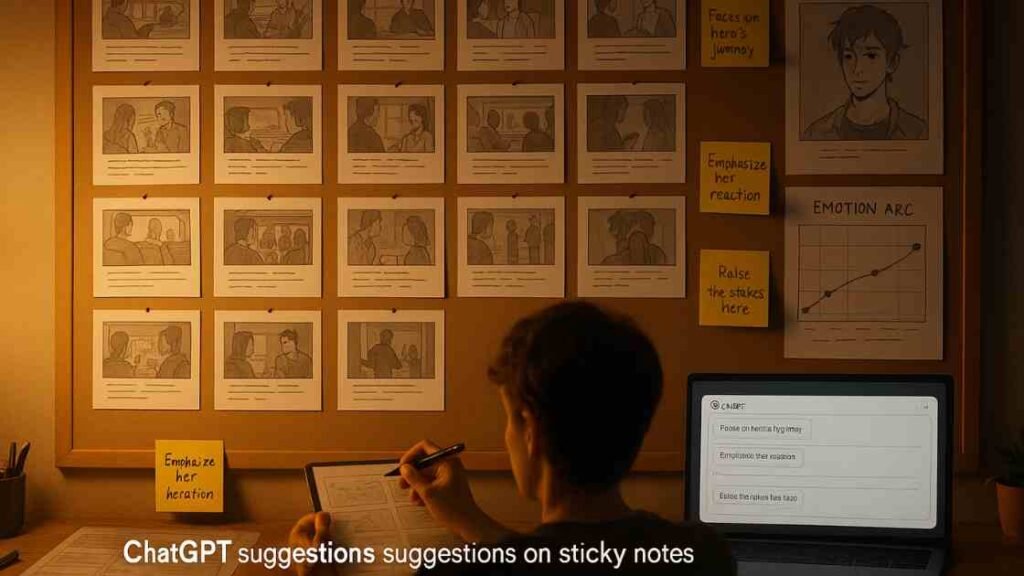
Example: A content creator developing a YouTube mini-series might ask ChatGPT to “write a three-part mystery script set in a coastal town with recurring clues and a poetic ending.” ChatGPT drafts a cohesive outline, proposes camera cues, and even suggests atmospheric sound design. The creator then adds local flavor, emotion, and pacing — producing a story that feels entirely human yet supported by AI precision.
In short, ChatGPT in 2025 has transformed storytelling into a shared art form between human and machine. Writers no longer face the blank page alone; instead, they collaborate with an ever-curious partner that never tires of exploring “what if.” The result is a new creative era — where imagination meets intelligence, and every story has the potential to evolve in ways limited only by the storyteller’s curiosity.
8. Data Analysis and Decision Making
One of the most practical and fast-growing ChatGPT use cases in 2025 is in data analysis and business decision making. Once limited to data scientists and analysts, AI-powered analytics are now accessible to anyone — from entrepreneurs and managers to students and freelancers — through natural-language interaction. ChatGPT has evolved into an intelligent data analyst and decision-support partner, capable of turning raw numbers into actionable insights.
Integration with Power BI, Google Sheets, and Tableau
With integrations across Microsoft Excel, Power BI, Google Sheets, and Tableau, ChatGPT can analyze massive datasets using simple text prompts. A marketing executive can upload a spreadsheet and ask, “Which campaign generated the highest ROI last quarter?” or “Show me customer retention trends by region.” Within seconds, ChatGPT interprets the data, runs calculations, and presents visual summaries — complete with charts, key insights, and plain-English explanations.
Predictive Insights and Trend Forecasting
This capability has democratized analytics for non-technical users. Teams no longer need advanced SQL or Python skills to understand their performance metrics. ChatGPT automatically detects data structures, identifies missing values, and recommends the best visualization type for each query. It can even predict outcomes using machine learning forecasting models, such as estimating next month’s sales or highlighting potential churn risk.
In corporate settings, ChatGPT acts as an AI business intelligence layer, bridging communication between departments. Finance teams use it to generate budget variance analyses, HR departments summarize employee engagement reports, and sales managers receive weekly dashboards delivered directly to Slack or email. Through Zapier or Power Automate, ChatGPT connects analytics workflows end-to-end — from pulling data to generating insights and scheduling reports.
This evolution has birthed a new concept: Conversational Analytics — where decision-makers simply talk to their data. Executives can ask questions like, “Why did Q2 performance drop despite increased marketing spend?” ChatGPT responds with contextual insights such as, “Conversion rates fell 12% due to low engagement from mobile users; retargeting ads performed below benchmark.” It explains patterns, pinpoints anomalies, and even recommends data-driven strategies to correct them.
Beyond corporate use, freelancers and creators also leverage ChatGPT for performance tracking. Influencers use it to analyze audience engagement trends, eCommerce sellers track inventory and pricing patterns, and website owners generate SEO performance summaries directly from analytics exports.
Example: Using ChatGPT for SEO and Conversion Data Analysis
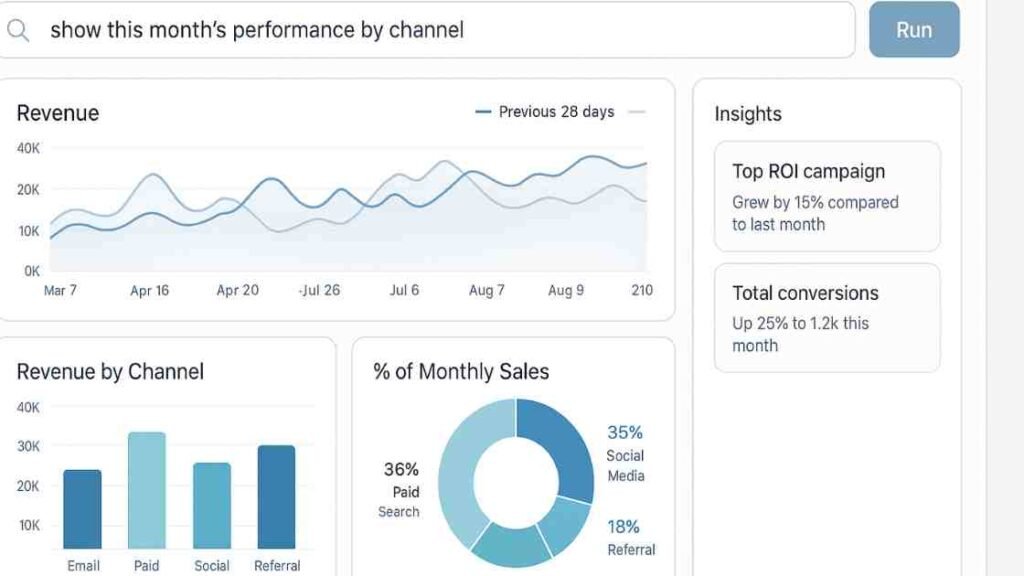
Example: A content strategist managing multiple blogs can upload Google Analytics data and prompt, “Summarize which pages drove the highest conversions this month and suggest related topics to boost organic traffic.” ChatGPT replies with a keyword-rich analysis, supporting charts, and recommendations aligned with semantic SEO and content clustering strategies.
For advanced teams, ChatGPT pairs with Python or R environments to support technical modeling. It can generate code snippets for regression analysis, customer segmentation, or predictive modeling, while explaining each step in natural language — effectively making AI a co-analyst rather than a black box.
As businesses rely more heavily on AI-driven insights, data literacy has become a core professional skill. ChatGPT not only delivers analytics but also teaches users how to interpret them. It explains correlation versus causation, simplifies statistical jargon, and provides balanced perspectives to avoid over-reliance on single metrics.
In 2025, data storytelling has replaced raw reporting — and ChatGPT sits at the center of this transformation. As smart devices become more autonomous, innovations such as Nubbin Technology highlight how embedded AI chips are bringing ChatGPT-style reasoning directly into IoT ecosystems.
By blending automation with human reasoning, it empowers decision-makers to understand their data intuitively and act with confidence. Instead of drowning in spreadsheets, leaders can now focus on strategy — with ChatGPT translating complexity into clarity, one conversation at a time.
9. Social Media and Brand Strategy
In 2025, one of the most profitable and time-saving ChatGPT use cases lies in social media and brand strategy. For influencers, small-business owners, and marketing agencies alike, ChatGPT has become the creative backbone behind campaigns that once required entire teams. From crafting captions to analyzing audience behavior, the AI now supports every stage of digital brand growth.
AI Campaign Planning and Scheduling with Buffer and Hootsuite
Today’s marketers no longer brainstorm in isolation. Integrated with Buffer, Later, Metricool, and Hootsuite, ChatGPT functions as an AI social-media strategist that can plan, schedule, and optimize content calendars. You can ask, “Create a 30-day Instagram posting plan for a skincare brand targeting UK audiences,” and ChatGPT delivers a detailed schedule complete with caption ideas, hashtag clusters, and visual-theme suggestions. These prompts can even sync directly with scheduling tools, automating entire campaign pipelines.
Trend Forecasting Across TikTok, Instagram, and YouTube Shorts
The 2025 version of ChatGPT also specializes in trend forecasting. By analyzing viral content patterns across platforms such as TikTok, Instagram Reels, X (formerly Twitter), and YouTube Shorts, it identifies what topics, sounds, or aesthetics are likely to perform best for your niche. This helps creators publish content before trends peak, giving them a competitive edge in visibility and engagement.
Businesses use ChatGPT for cross-platform consistency. It adapts the same message across multiple channels — transforming a long-form blog into a carousel post for LinkedIn, a short-form video script for TikTok, or a tweet thread for X — all while preserving brand tone and intent. This multi-modal repurposing ensures that each platform speaks the right language to its audience without diluting the brand’s personality.
What makes ChatGPT invaluable is its ability to analyze engagement metrics. Integrated with Google Analytics, Meta Insights, and social-listening APIs, it interprets metrics like reach, click-through rate, and watch time in plain English. Marketers can ask, “Why did engagement drop on last week’s posts?” and ChatGPT replies with data-driven reasoning: “Your content frequency increased, but caption length and posting times reduced average retention by 18 %. Try shorter reels between 6–9 p.m. to recapture engagement.”
Consistent Multi-Platform Branding and Storytelling
Personalization has also evolved. ChatGPT can segment audiences based on psychographics, location, or purchase intent, then generate custom messaging for each group. E-commerce brands use it to write promotional copy that matches buyer behavior — from playful Gen Z humor to professional B2B tones — resulting in higher conversion rates and stronger loyalty.
This new wave of AI-assisted branding aligns closely with semantic SEO principles, ensuring every caption and campaign ties back to a unified topical ecosystem. ChatGPT identifies interlinking opportunities between website blogs, landing pages, and social content, improving both visibility and brand authority across search and social platforms.
Influencers, too, benefit from AI-enhanced storytelling. Many use ChatGPT to craft authentic captions, gratitude posts, or storytelling arcs that engage audiences emotionally rather than mechanically. It helps creators balance consistency with personality — a challenge in the algorithm-driven world of social media.
Example: Creating Captions and Hashtag Clusters for Sustainable Brands
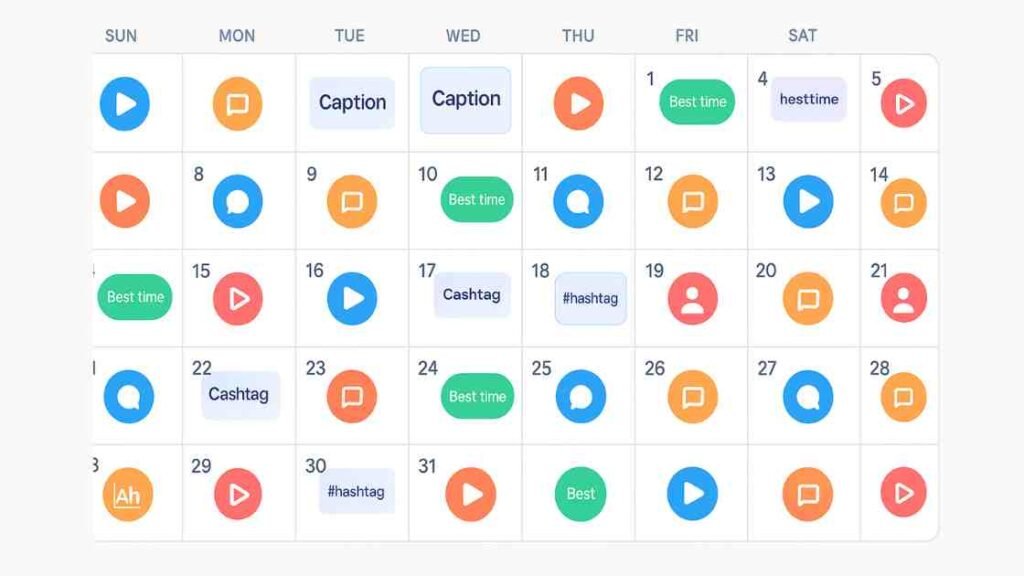
Example: A sustainable fashion influencer can ask ChatGPT, “Write 10 Instagram captions that highlight slow fashion and community impact, each under 100 words with hashtag suggestions.” The AI generates captions that mix education, empathy, and brand ethos — saving hours of manual writing while maintaining authenticity.
Ultimately, ChatGPT in 2025 empowers brands to think strategically, create efficiently, and connect meaningfully. It doesn’t replace creativity; it organizes and amplifies it. By merging analytics, automation, and storytelling into one intelligent system, ChatGPT has become the marketer’s all-in-one co-pilot — guiding every post, caption, and campaign toward purpose, precision, and profit.
10. Personal Growth, Journaling, and Therapy Support
Among the most surprising yet meaningful ChatGPT use cases in 2025 is its growing role in personal growth, mindfulness, and emotional self-care. What began as a productivity assistant has evolved into a reflective companion that helps users slow down, observe their thoughts, and cultivate emotional balance through guided journaling and conversation.
AI-Guided Cognitive Reframing and Mindfulness Coaching
People around the world now use ChatGPT as part of their daily mental-wellness routine. They begin mornings with prompts like “List three things I’m grateful for and explain why,” or end evenings with “Help me reflect on today’s biggest lesson.” ChatGPT responds with gentle, structured reflections that nudge users toward clarity rather than judgment. Over time, these small exchanges help individuals recognize thought patterns, reframe stress, and track personal progress — turning everyday dialogue into emotional insight.
Powered by improved Natural-Language Understanding and affective modeling, ChatGPT can recognize tone and emotion in user input. It adapts its responses accordingly — offering encouragement when users express frustration or suggesting breathing or grounding exercises when anxiety appears in language patterns. This has positioned it as a supportive, non-clinical extension of self-care that complements, not replaces, professional therapy.
Modern wellness platforms Replika, and Wysa now integrate ChatGPT APIs to deliver personalized mindfulness programs. Users receive AI-guided meditation scripts, gratitude templates, or CBT-based reframing exercises tailored to their mood and goals. For example, when someone types, “I’m feeling unproductive and guilty about it,” ChatGPT may respond with a reframing prompt inspired by Cognitive Behavioral Therapy (CBT):
“What evidence supports that thought? What evidence challenges it? Let’s explore a more balanced perspective.”
Beyond CBT, ChatGPT incorporates elements of Acceptance and Commitment Therapy (ACT) — encouraging users to observe emotions without judgment and focus on values-driven actions. This approach makes AI-guided journaling more compassionate and constructive, promoting long-term resilience rather than instant positivity.
Creative individuals use ChatGPT as a reflective writing coach. Authors use it to explore character emotions through journaling exercises; students record gratitude reflections to reduce burnout; and entrepreneurs employ it to process setbacks and rediscover motivation. Through repetition, ChatGPT helps users transform fragmented thoughts into coherent self-narratives — a cornerstone of psychological well-being.
Ethically, responsible AI use in mental health is crucial. In 2025, ChatGPT includes privacy-first safeguards: encrypted chat storage, clear disclaimers that it’s not a licensed therapist, and transparent referrals to professional resources for crisis or severe distress. This ensures that users receive comfort without crossing the boundaries of clinical care.
Example: Guided Self-Compassion and Gratitude Exercises
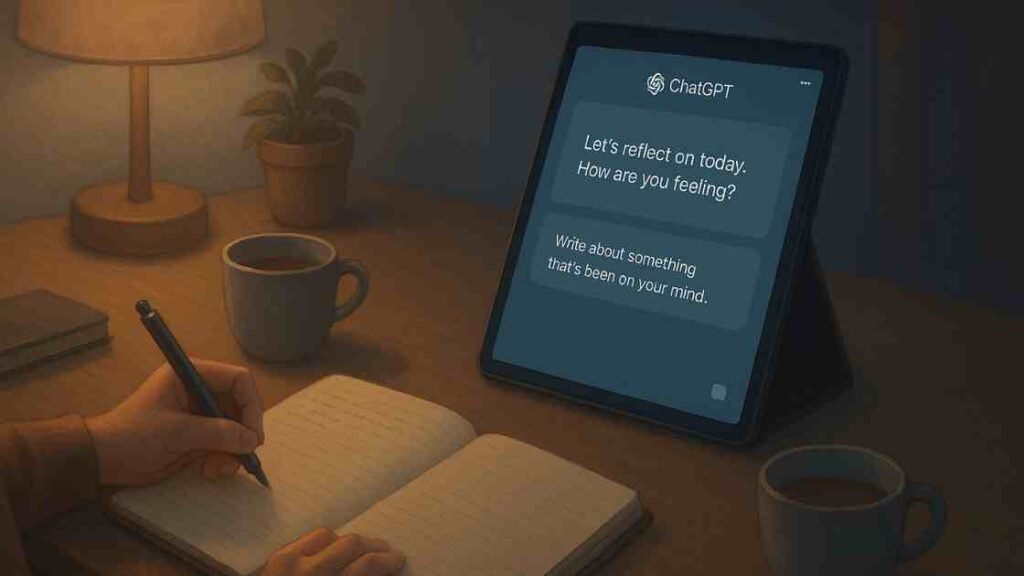
Example: A user might type, “I feel overwhelmed by constant comparison on social media.” ChatGPT could respond:
“It’s completely natural to feel that way in a comparison-driven world. Let’s identify what triggers those feelings and create a grounding habit — perhaps journaling one genuine achievement each day.”
Such empathetic exchanges foster self-awareness while offering practical coping mechanisms rooted in behavioral science.
The combination of AI reflection and human intention has made self-improvement more accessible than ever. ChatGPT serves as a patient listener, an organized journal, and a mindful mirror that encourages introspection over impulsivity. When paired with human guidance or counseling, it strengthens mental-health habits by bridging daily awareness with professional insight.
Ultimately, ChatGPT in 2025 redefines digital well-being — not as a productivity hack, but as a pathway to presence, gratitude, and self-compassion. By transforming simple conversations into structured reflection, it reminds us that technology, when guided by empathy and ethics, can help heal, not just help perform.
Bonus: ChatGPT for Small Businesses and Entrepreneurs
In 2025, one of the most empowering ChatGPT use cases is its ability to level the playing field for small businesses and entrepreneurs. What once required full marketing teams, copywriters, and analytics specialists can now be achieved by a single founder using AI-driven tools — allowing small ventures to compete confidently with global brands.
ChatGPT has become the ultimate business co-pilot, guiding entrepreneurs from idea to execution. Whether launching a Shopify store, optimizing Amazon listings, or running a digital agency, small-business owners use ChatGPT to save time, cut costs, and maintain professional standards across content, communication, and customer engagement.
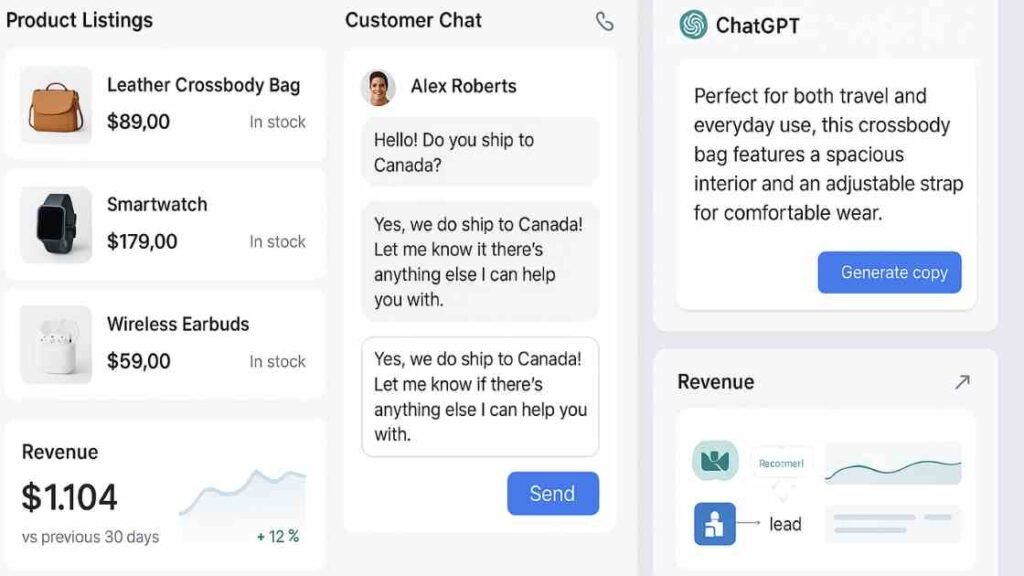
1. Market Research and Business Planning
Start-ups use ChatGPT to conduct real-time market research without expensive analytics tools. By analyzing competitor data, trending products, and consumer sentiment, it helps entrepreneurs identify profitable niches before investing. For example, a founder can ask, “List five trending product categories in the UK fitness market with low competition,” and ChatGPT returns data-backed insights with potential target demographics and keyword recommendations.
This capability extends into business modeling. ChatGPT can generate SWOT analyses, pricing strategies, and even brand mission statements that align with modern consumer values such as sustainability or personalization. When integrated with tools like Google Trends, Ubersuggest, or Ahrefs, it transforms into a data-informed strategist — reducing research cycles from weeks to minutes.
2. E-Commerce Content and Product Listings
For e-commerce entrepreneurs, ChatGPT acts as both a content engine and optimization assistant. Shopify and Amazon sellers use it to write SEO-rich product descriptions, bullet points, and titles that improve click-through rates. The AI understands each platform’s algorithmic preferences, generating copy tailored for ranking and conversion.
Example: A seller on Amazon UAE can prompt, “Write an optimized product listing for a stainless-steel water bottle targeting eco-conscious customers,” and ChatGPT creates a full listing with persuasive copy, feature highlights, and LSI keyword placement for visibility.
When integrated with Shopify’s AI tools or Canva, ChatGPT can also generate brand stories, meta descriptions, and banner text — ensuring consistent messaging across every customer touchpoint. This harmony between content and design forms the foundation of AI-driven brand storytelling, where efficiency meets creativity.
3. Customer Service and Automation
Customer support — once one of the most labor-intensive business operations — is now largely automated through ChatGPT-powered chatbots. Entrepreneurs deploy these bots on their websites or WhatsApp Business accounts to respond instantly to FAQs, track orders, and provide personalized product recommendations.
Unlike rigid chat scripts of the past, ChatGPT’s natural-language adaptability allows genuine, human-like conversations. It can detect tone, sentiment, and intent — escalating sensitive issues to a human agent when necessary. This ensures responsiveness without compromising empathy, creating smoother customer experiences.
Through Zapier or HubSpot CRM, ChatGPT also automates follow-ups, lead scoring, and client feedback surveys. For small agencies and freelancers, this means reduced administrative workload and increased customer retention through proactive, personalized communication.
4. Marketing, Branding, and Email Campaigns
Marketing automation has seen a revolution through ChatGPT’s creative intelligence. Entrepreneurs now use it to craft email campaigns, ad copy, and social captions that align with seasonal trends and audience emotion. It can generate full launch strategies, including blog posts, newsletters, and video scripts — maintaining consistent tone and SEO alignment across channels.
When paired with Rank Math or SurferSEO, ChatGPT optimizes content for search visibility, ensuring that small-business blogs and landing pages rank competitively in Google results. This strategic use of semantic SEO and natural language generation allows even micro-brands to attract organic traffic and build authority.
5. Financial and Operational Support
Beyond creative work, ChatGPT assists entrepreneurs in managing operations and finances. It can draft invoices, summarize expense sheets, and prepare investor updates using data from Google Sheets or QuickBooks. With access to business data, ChatGPT can answer queries like, “Summarize this quarter’s profit margins and predict next quarter’s break-even point.” This makes it a valuable tool for founders who may not have formal accounting expertise.
Example: A solopreneur running a digital-print store can use ChatGPT to generate product descriptions, schedule social posts, respond to customer emails, and track daily revenue — all within one dashboard using connected apps like Notion, Shopify, and Gmail.
Ultimately, ChatGPT in 2025 empowers small businesses to scale smarter, not harder. It blends creativity with analytics, transforming entrepreneurs into strategic thinkers rather than task managers. By automating repetitive processes and enhancing decision-making, ChatGPT gives founders what they need most — time to innovate, connect with customers, and build brands that matter.
The Future of ChatGPT: From Assistant to Ecosystem
As we look beyond 2025, ChatGPT has evolved far beyond being a conversational assistant — it has become an entire ecosystem of intelligence, automation, and creativity. What started as a text-based chatbot is now a dynamic, multimodal platform capable of processing language, visuals, audio, and data simultaneously. The world no longer interacts with ChatGPT; it collaborates with it.
The emergence of multi-agent AI collaboration — where multiple AI systems communicate and coordinate tasks — represents the next great leap in human–machine partnership. Imagine a seamless workflow where one AI agent researches market trends, another designs visuals, and a third writes SEO-optimized copy — all under the user’s direction through ChatGPT’s central interface. This integrated ecosystem will redefine productivity, merging creativity, logic, and automation into one cohesive digital experience.
In professional environments, ChatGPT is expected to become a universal AI layer — embedded across platforms, devices, and industries. From smart homes to cloud infrastructure, ChatGPT’s reasoning capabilities will power personalized automation. Professionals will be able to command entire systems using natural speech: “Summarize this week’s sales,” “Edit my upcoming campaign for sustainability tone,” or “Prepare my tax report for submission.” The line between human intent and digital execution will blur completely.
Education and research will benefit from even deeper AI-human collaboration. As AI tutors evolve, they will track learning styles, adjust teaching pace, and assess emotional engagement — creating learning environments that adapt to the student, not the other way around. Researchers will use ChatGPT as both an analytical engine and a thought partner, able to propose hypotheses, interpret results, and translate complex findings into accessible language.
In the creative space, ChatGPT’s multimodal intelligence will continue bridging text, design, and media. Writers will collaborate with AI co-authors who understand tone and symbolism, designers will describe visuals in words that instantly transform into cinematic imagery, and musicians will use voice-based prompts to compose soundscapes in real time. Creativity will no longer be bound by technical skill but guided by human imagination and AI execution.
Ethical development remains the defining conversation for the next generation of AI. Transparency, privacy, and digital well-being will determine how society integrates these tools responsibly. The AI ethics frameworks of 2025 emphasize accountability, bias prevention, and human oversight — ensuring that innovation serves humanity rather than replacing it. OpenAI and similar organizations are now prioritizing explainable models, localized datasets, and accessibility, so AI progress benefits global users equitably.
At its core, ChatGPT’s evolution mirrors our own — a pursuit of understanding, efficiency, and connection. It reminds us that AI’s greatest potential lies not in replacing human creativity but amplifying it. The most successful professionals, educators, and entrepreneurs of this decade are not those who fear automation but those who learn to harness it thoughtfully.
And just as voice-assisted robots like Amazon Astro UK 2025 bring AI into our living spaces, ChatGPT continues to extend its role as an intelligent co-pilot in our digital and physical worlds.
From writing blogs and automating workflows to fostering emotional resilience and business growth, ChatGPT in 2025 represents the fusion of intelligence and empathy — a tool that listens, learns, and evolves alongside us. The coming years will likely see it transform into a true AI companion ecosystem, one that integrates seamlessly into our work, learning, and personal lives — empowering people not just to be more productive, but to be more human.
Frequently Asked Questions (FAQ) — ChatGPT Use Cases 2025
1. What are the most common ChatGPT use cases in 2025?
The most common ChatGPT use cases in 2025 include content creation, blogging, academic research, coding assistance, business communication, and workflow automation. People also use ChatGPT daily for creative writing, social media marketing, data analysis, personal growth, and even therapy-inspired journaling.
2. How is ChatGPT used for work in 2025?
In professional settings, ChatGPT helps automate repetitive tasks, generate marketing content, summarize reports, and support customer interactions. Many teams use it as a virtual assistant for emails, meeting summaries, and brainstorming sessions, improving both efficiency and creativity at work.
3. Can students safely use ChatGPT for study and research?
Yes — when used ethically, ChatGPT is a valuable study companion. It simplifies complex theories, explains academic models, and generates study notes or quizzes. Students can also ask ChatGPT to summarize academic papers or help format citations in APA or MLA style. However, it should support learning, not replace original work.
4. How do developers use ChatGPT in software development?
Developers use ChatGPT to write and debug code, generate documentation, and translate logic between programming languages. With integrations like GitHub Copilot X, it can review code quality, suggest optimizations, and even simulate APIs or frameworks for testing environments.
5. What are real-world ChatGPT applications for small businesses?
Small business owners use ChatGPT to create marketing campaigns, write SEO product descriptions, handle customer queries, and manage emails. It’s also popular for social media strategy, generating brand stories, and automating routine operations through integrations with Shopify, Canva, and HubSpot.
6. How is ChatGPT improving personal productivity in 2025?
ChatGPT automates everyday tasks such as scheduling, report summarization, content drafting, and even habit tracking. With integrations like Zapier, Notion, and Google Workspace, it acts as a personalized digital assistant that helps users stay organized and productive.
7. Can ChatGPT be used for creativity and storytelling?
Absolutely. Writers, filmmakers, and artists use ChatGPT to develop stories, dialogue, characters, and scripts. In 2025, it collaborates with AI image generators like DALL·E and Midjourney to visualize concepts — turning creative ideas into structured projects faster than ever.
8. What are some educational ChatGPT use cases in 2025?
Teachers and students use ChatGPT for lesson planning, quiz creation, concept revision, and real-time tutoring. Educational platforms integrate it to provide personalized feedback, help with assignments, and generate learning paths tailored to each student’s pace and style.
9. How do people use ChatGPT for mental health and self-reflection?
ChatGPT assists users with mindfulness exercises, gratitude journaling, and emotional reframing. It uses evidence-based frameworks like CBT (Cognitive Behavioral Therapy) to promote self-awareness and resilience. While it’s not a replacement for therapy, it serves as a powerful self-help and reflection tool.
10. What’s the future of ChatGPT beyond 2025?
Beyond 2025, ChatGPT is evolving into a multi-agent AI ecosystem — combining conversational intelligence with real-time data, automation, and emotional context. Future versions may integrate seamlessly into wearable devices and AR environments, making AI a natural extension of daily human interaction.


